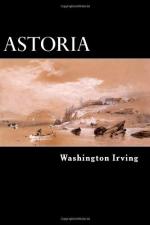The next day (October 21st), the cold continued, accompanied by snow. They set forward on their bleak and toilsome way, keeping to the east northeast, towards the lofty summit of a mountain, which it was necessary for them to cross. Before they reached its base they passed another large trail, steering a little to the right of the point of the mountain. This they presumed to have been made by another band of Crows, who had probably been hunting lower down on the Spanish River.
The severity of the weather compelled them to encamp at the end of fifteen miles, on the skirts of the mountain, where they found sufficient dry aspen trees to supply them with fire, but they sought in vain about the neighborhood for a spring or rill of water.
At daybreak they were up and on the march, scrambling up the mountain side for the distance of eight painful miles. From the casual hints given in the travelling memoranda of Mr. Stuart, this mountain would seem to offer a rich field of speculation for the geologist. Here was a plain three miles in diameter, strewed with pumice stones and other volcanic reliques, with a lake in the centre, occupying what had probably been the crater. Here were also, in some places, deposits of marine shells, indicating that this mountain crest had at some remote period been below the waves.
After pausing to repose, and to enjoy these grand but savage and awful scenes, they began to descend the eastern side of the mountain. The descent was rugged and romantic, along deep ravines and defiles, overhung with crags and cliffs, among which they beheld numbers of the ahsahta or bighorn, skipping fearlessly from rock to rock. Two of them they succeeded in bringing down with their rifles, as they peered fearlessly from the brow of their airy precipices.
Arrived at the foot of the mountain, the travellers found a rill of water oozing out of the earth, and resembling in look and taste, the water of the Missouri. Here they encamped for the night, and supped sumptuously upon their mountain mutton, which they found in good condition, and extremely well tasted.
The morning was bright, and intensely cold. Early in the day they came upon a stream running to the east, between low hills of bluish earth, strongly impregnated with copperas. Mr. Stuart supposed this to be one of the head waters of the Missouri, and determined to follow its banks. After a march of twenty-six miles, however, he arrived at the summit of a hill, the prospect of which induced him to alter his intention. He beheld, in every direction south of east, a vast plain, bounded only by the horizon, through which wandered the stream in question, in a south-south-east direction. It could not, therefore, be a branch of the Missouri. He now gave up all idea of taking the stream for his guide, and shaped his course towards a range of mountains in the east, about sixty miles distant, near which he hoped to find another stream.




